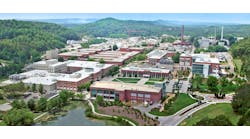Data Center Alternative Energy Takes Center Stage with Ballard, Vertiv Technology Integration
In a collaboration to demonstrate the feasibility and practicality of hydrogen fuel cell solutions for backup and microgrid power aimed at data centers, Vertiv has containerized integration of a Ballard PEM fuel cell with their Leibert UPS systems.
The system integration stands as proof-of-concept technology demonstration installed at the Vertiv facility in Delaware, Ohio. The two companies have announced a strategic technology partnership to support alternative energy usage for data centers in North America and EMEA.
While not exactly an off-the-rack solution, the technology, termed the Power Module H2 solution by Vertiv, combines two Ballard PowerGen 200kW fuel cell cabinets, Vertiv HPL Li-on batteries, a Liebert EXL S1 UPS system, the Vertiv DynaFlex Energy Management Controller, a complete cooling sub-system, power conditioning equipment, and the hydrogen storage system -- in a single container.
Viktor Petik, Vice President of Vertiv Infrastructure Solutions, remarked, “The successful fuel cell proof-of-concept with Ballard provides a viable option for customers strengthening their data center sustainability strategy, and those moving to a future-ready Bring Your Own Power (BYOP) model.”
Zero GHG Emissions for Data Center Backup Power Generation
The Power Module H2 is designed to directly address the increasing energy demands of the data center industry, while also providing zero GHG emissions backup power generation, directly competing with the diesel generator backup power market.
The complete module, configured to meet customer needs, is a prefabricated and factory-tested solution.
As pointed out by Nicolas Pocard, Vice President of Marketing and Strategic Partnerships for Ballard, "[As] the soaring increase in data usage is driving up power demand and expansion of data center capacity globally, the need to effectively manage electricity consumption and the carbon footprint of this energy-intensive sector is critical to achieve net-zero targets.”
The Ballard PEM fuel cell technology is available in sizes from 200 kW to well into the MW range.
As installed at the Vertiv facility, the combined technologies are part of the MW Vertiv Customer Experience Center microgrid solution which also includes a 1MW AC Solar PV array and the Vertiv DynaFlex Battery Energy Storage System (BESS).
A Timely Collaboration
Given the interest in data center development looking at on-site power generation and microgrids, and the importance of these technologies in being able to work with power generation utilities in managing energy demand and usage, the practical technology demonstration between Vertiv and Ballard is timely.
The combination of hydrogen fuel-cells with battery-based energy storage systems, as well as energy management hardware and software and practical deployment structures, touches on many current industry flash points.
Vertiv first demonstrated the integration of a UPS and fuel cells back in October 2023 at their Customer Experience Center in Columbus, Ohio.
Beyond demonstrating the practicality of the solution, the CEC demonstrates to customers potential ways to advance their resource management to systematically plan their future upgrade path.
Vertiv identifies these advantages to the Power Module H2 solution compared to tradition diesel backup power generation:
- Single-supplied complex power infrastructure.
- Zero GHG emission and low noise backup power generation.
- Rapid Dynamic power response.
- Low maintenance compared to diesel generator backup solutions.
- Extended backup (days) – limited only by fuel storage capacity.
- Optimized footprint for MW scale applications.
- Scalable in multi-MW UPS and Fuel Cell applications.
The overall reduction in the use of fossil fuel and the reduced carbon footprint yielded by the new technology integration goes a long way to helping data centers address their ongoing sustainability goals, and demonstrates a commitment by both companies to being community leaders in environmental responsibility.







